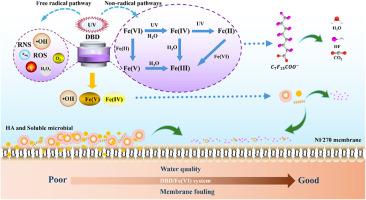Sustainable approach for landfill leachate treatment through dielectric barrier discharge/ferrate (DBD/Fe(VI)) enhanced nanofiltration
IF 8.4
1区 工程技术
Q1 ENGINEERING, CHEMICAL
引用次数: 0
Abstract
Landfill leachate, with its high concentrations of persistent organic pollutants, salts, heavy metals, and emerging contaminants, presents significant environmental challenges. This study investigated the combination of dielectric barrier discharge (DBD) and ferrate (Fe(VI)) pretreatment technology in landfill leachate treatment, focusing on its effectiveness in enhancing oxidation performance and mitigating membrane fouling. The results indicated that after DBD/Fe(VI) treatment, TOC and UV254 removal efficiencies increased by 44 % and 67 %, respectively. Additionally, the DBD/Fe(VI) system excelled in removing fluorescent substances and high molecular weight organic compounds, thereby reducing the formation of the cake layer on the nanofiltration membrane. This system enhanced oxidation performance through the synergistic production of reactive intermediates, with Fe(V)/Fe(IV) and •OH being the main active species, O2•-, and 1O2 also contributing significantly. The degradation pathway of perfluorooctanoic acid was investigated by utilizing it as the representative pollutant. Compared to the raw landfill leachate system, the DBD/Fe(VI) increased membrane flux by 104 %, while reducing reversible and irreversible fouling resistances by 67 % and 75 %, respectively. Furthermore, the advantages and practical application potential of the DBD/Fe(VI) system were evaluated from energy consumption, economic cost, and carbon dioxide emissions. The study offers an innovative method for landfill leachate treatment and fouling mitigation.

通过介质阻挡放电/铁(DBD/Fe(VI))增强型纳滤处理垃圾填埋场渗滤液的可持续方法
垃圾填埋场渗滤液中含有高浓度的持久性有机污染物、盐类、重金属和新出现的污染物,给环境带来了巨大挑战。本研究调查了在垃圾填埋场渗滤液处理中结合使用介质阻挡放电(DBD)和铁酸盐(Fe(VI))预处理技术的情况,重点关注其在提高氧化性能和减轻膜堵塞方面的有效性。结果表明,经过 DBD/Fe(VI) 处理后,TOC 和 UV254 的去除率分别提高了 44% 和 67%。此外,DBD/Fe(VI) 系统在去除荧光物质和高分子量有机化合物方面表现出色,从而减少了纳滤膜上滤饼层的形成。该系统通过协同产生反应性中间产物来提高氧化性能,Fe(V)/Fe(IV) 和 -OH 是主要的活性物种,O2-- 和 1O2 也有重要贡献。以全氟辛酸为代表污染物,研究了其降解途径。与未处理的垃圾填埋场渗滤液系统相比,DBD/Fe(VI) 使膜通量提高了 104%,同时使可逆和不可逆污垢阻力分别降低了 67% 和 75%。此外,还从能耗、经济成本和二氧化碳排放等方面评估了 DBD/Fe(VI) 系统的优势和实际应用潜力。该研究为垃圾填埋场渗滤液处理和污垢缓解提供了一种创新方法。
本文章由计算机程序翻译,如有差异,请以英文原文为准。
求助全文
约1分钟内获得全文
求助全文
来源期刊

Journal of Membrane Science
工程技术-高分子科学
CiteScore
17.10
自引率
17.90%
发文量
1031
审稿时长
2.5 months
期刊介绍:
The Journal of Membrane Science is a publication that focuses on membrane systems and is aimed at academic and industrial chemists, chemical engineers, materials scientists, and membranologists. It publishes original research and reviews on various aspects of membrane transport, membrane formation/structure, fouling, module/process design, and processes/applications. The journal primarily focuses on the structure, function, and performance of non-biological membranes but also includes papers that relate to biological membranes. The Journal of Membrane Science publishes Full Text Papers, State-of-the-Art Reviews, Letters to the Editor, and Perspectives.
 求助内容:
求助内容: 应助结果提醒方式:
应助结果提醒方式:


